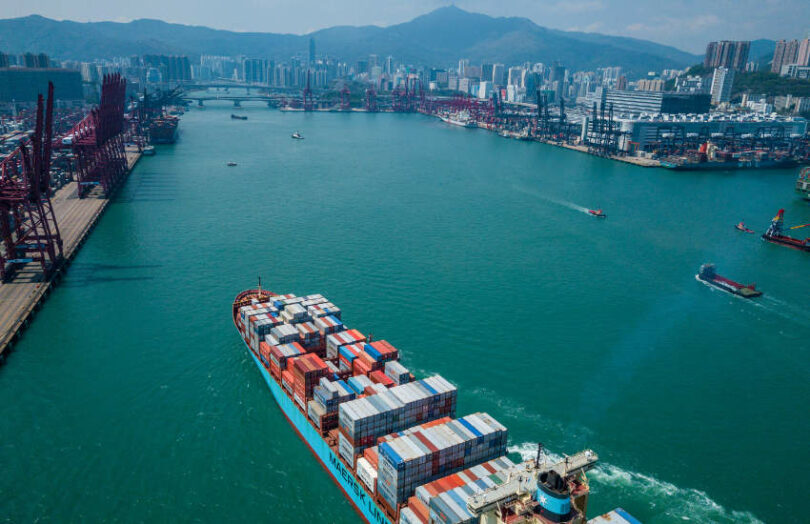Hong Kong’s Global Shipping Business Network (GSBN) and Ant Group’s ZAN are partnering to tokenize bills of lading, a foundational document in trade finance. Using blockchain to tokenize this document could empower more access to alternative sources of finance for this market. Last year global trade finance reached $23.8 trillion, according to the International Chamber of Commerce.
GSBN is a non profit blockchain consortium aiming to digitize global trade. Participants include some of the world’s largest shipping carriers such as COSCO Shipping Lines, Hapag Lloyd, ONE and OOCL, as well as several major port operators.
Meanwhile, Alipay owner Ant Group, recently created the ZAN brand to offer dedicated web3 solutions for real world assets (RWA). One of ZAN’s roles in this partnership is to take electronic bills of lading issued on the GSBN network and tokenize them on multiple other blockchain networks.
GSBN and ZAN are keen to move fast. Despite only just signing a memorandum of understanding (MoU), they plan to have a proof of concept before year’s end.
It’s estimated that 80% to 90% of current trade relies on trade finance. However, the Asian Development Bank (ADB) found there’s more than $2.5 trillion in trade that is looking for trade finance but can’t get it. Potentially tokenization might help address that. And for those with access to trade finance, greater competition between funders should reduce costs. Today the bill of lading is the key document used in Letters of Credit issued by banks. The International Chamber of Commerce (ICC) estimates that LCs and guarantees account for 42% of trade finance.
Most of all, tokenization might help to drive the digitization of the trade process, which is surprisingly paper based even post COVID.
The push for electronic bills of lading
When an exporter loads cargo onto a ship, the shipping carrier issues a bill of lading, a key document in the transfer of title to the goods. In 2022, just 2.1% of the 45 million bills of lading and waybills were digital, up from 1.2% in 2021.
There’s a massive push towards electronic bills of lading (eBL) by several major trade bodies. For example, the Digital Container Shipping Association (DCSA) secured commitments from nine of the ten largest shipping carriers to adopt eBL for 50% of shipments by 2028, and 100% by 2033.
Another piece of the puzzle is supportive laws. The United Kingdom is the dominant legal foundation for trade, and it recently passed the Electronic Trade Documents Act.
Tokenizing eBL and interoperability
“We are in the right place at the right time. The move towards eBL is already a major leap for the industry but together with tokenisation, we can go one step further,” said Bertrand Chen, CEO at GSBN. Beyond eBL, he also believes Hong Kong is the right jurisdiction with a government that’s supportive of web3.
Talking to Ledger Insights, he cited the tailwind of the push towards eBL digitization.
However, it needs more than carrier commitment to make it happen. Currently there are ten different eBL solutions. That would mean every shipping carrier, logistics company and bank supporting ten incompatible solutions.
“It’s a good thing that everybody understands that if you don’t have interoperability, it’s very hard to scale to 100 percent adoption of eBL,” said Chen. “You have different solutions, rulebooks that are incompatible. It’s a bad thing in the sense that everybody’s like, let’s wait for interoperability to be fully realized before we push energy towards this.”
The DCSA has been working on solutions for interoperability for more than a year and GSBN is also involved. “I’m confident that actually interoperability will happen much faster than most people would think,” said Chen. He believes there will be a solution within the year addressing all aspects, including legal and technical ones.
eBL and the matter of trust
Part of the reason for the current eBL push is efficiencies, but also a potential reduction in fraud given the holder of a bill of lading can raise finance and unload the cargo. Using digital signatures and cryptography helps to prove that the shipping carrier issued the eBL rather than a tweaked photocopy of a document.
However, while blockchain is useful as an anti fraud tool, it still needs an inspection to verify the cargo is what it’s claimed to be. That said, the combination of actors involved, from shipping carriers to auditors can help provide so-called trust anchors for tokenization. The eBL from the carrier on the GSBN platform can have a signed inspection document attached. The GSBN eBL can then be tokenized on other blockchains, public or private.
“I trust this auditor to go and check the tank of the ship itself. I trust those guys who verify this container,” said Chen. “Then this entire ecosystem can thrive, because you have this trust anchor and you can go back and audit. It’s directly the digital trail, which doesn’t exist today.”






